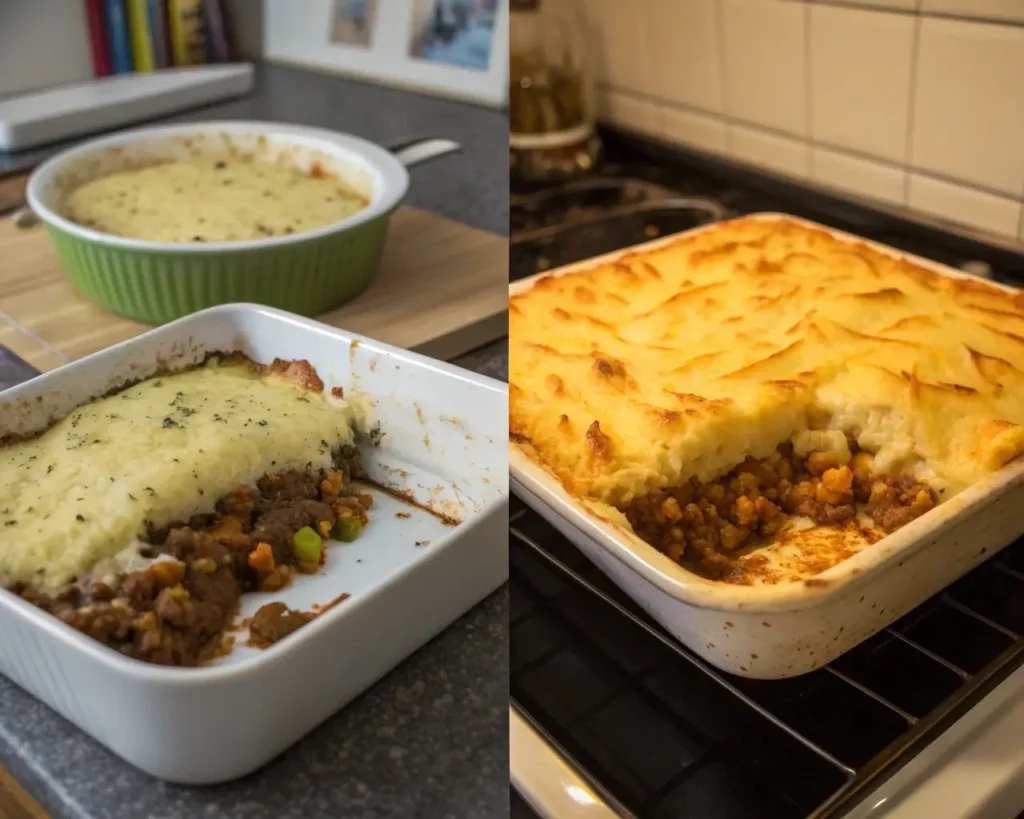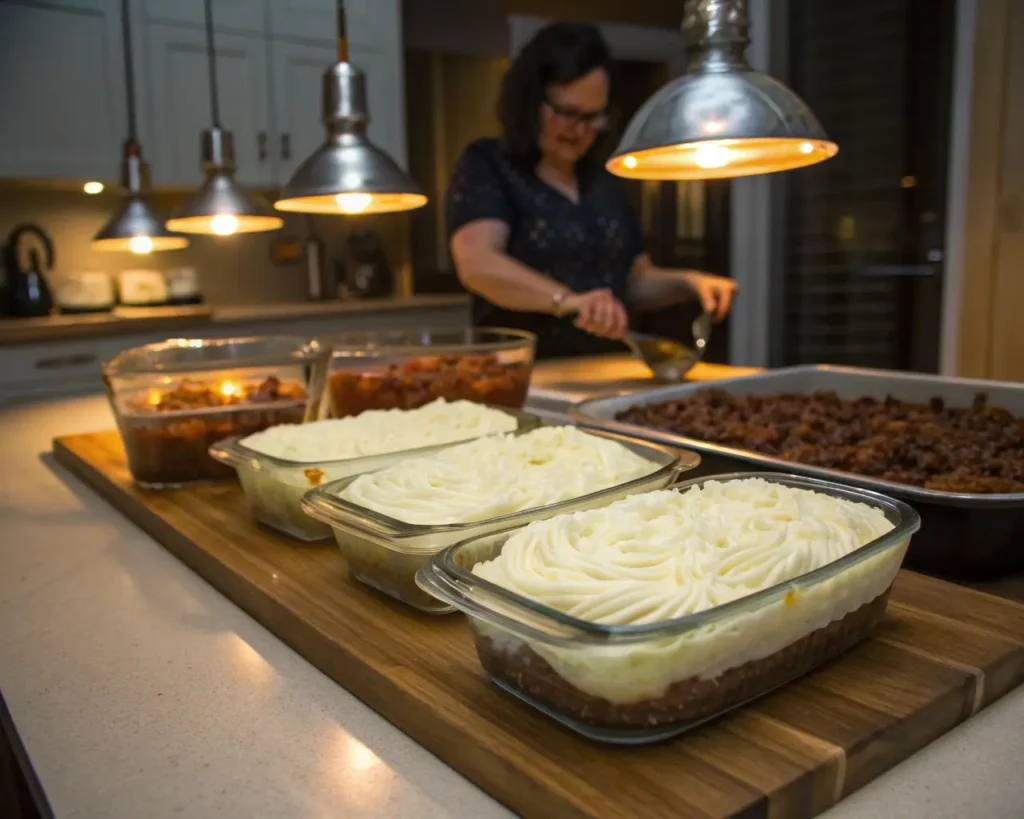Every home cook has been there—you spend hours crafting what should be the perfect Shepherd’s Pie, only to serve up a soggy, disappointing mess that bears little resemblance to your culinary dreams. The meat mixture bleeds into the potatoes, the bottom turns to mush, and what should have been comfort food perfection becomes a lesson in kitchen humiliation.
But what if I told you there’s one overlooked technique that separates restaurant-quality Shepherd’s Pie from the soggy disasters most home cooks unknowingly create? It’s not about expensive ingredients or complicated procedures. This secret has been hiding in plain sight in professional kitchens for decades, yet somehow never made it into mainstream recipes.
The secret? Strategic moisture management through thermal barriers and deliberate dehydration.
Sounds fancy, doesn’t it? But here’s the thing—most people think Shepherd’s Pie failure comes from seasoning issues or improper browning. Wrong. The real culprit is moisture migration, and once you understand how to control it, you’ll never serve a soggy Shepherd’s Pie again.

Understanding the Moisture Problem Most Ignore
Here’s what’s actually happening in your oven that nobody talks about: when your meat mixture heats up, it releases steam and liquid. Traditional recipes tell you to layer hot filling directly under mashed potatoes, creating a moisture trap that turns your beautiful creation into a watery mess.
Think about it—when was the last time you saw a restaurant Shepherd’s Pie that fell apart on the plate? Professional kitchens figured out this moisture issue years ago, but somehow the solution never trickled down to home cooking resources.
The overlooked reality is that moisture moves upward during cooking. Your meat layer is essentially steaming your potato layer from below while the oven heat creates condensation from above. It’s a moisture sandwich, and your Shepherd’s Pie is caught in the middle.
Why don’t most recipes address this? Honestly, I think cookbook writers assume home cooks won’t bother with “extra” steps. But this isn’t extra—it’s essential.
Secret Component #1: The Bread Crumb Barrier

Professional kitchens use a thin layer of seasoned breadcrumbs between the meat and potato layers. Not for flavor—though it doesn’t hurt—but as a moisture barrier that absorbs excess liquid while maintaining structural integrity.
Mix panko breadcrumbs with grated Parmesan cheese and a pinch of dried herbs. Sprinkle this mixture evenly over your cooked meat layer before adding potatoes. During cooking, this barrier absorbs upward moisture while creating a subtle textural contrast that elevates the entire dish.
The breadcrumbs essentially act like a sponge, soaking up excess moisture that would otherwise compromise your potato topping. It’s such a simple addition, yet it transforms the entire eating experience.
Secret Component #2: The Dehydration Window
Here’s where timing becomes crucial, and where most home cooks go wrong without realizing it.
After cooking your meat mixture, let it cool for exactly 10-15 minutes before assembly. This isn’t about food safety—it’s about allowing excess moisture to evaporate and the mixture to set slightly. Hot filling releases more steam during final cooking, while properly cooled filling maintains its structure.
During this cooling window, leave your meat mixture uncovered. You want surface moisture to escape. Professional kitchens use this exact technique during prep periods, allowing components to reach optimal temperature and moisture levels before final assembly.
But here’s the part that might surprise you: slightly cool filling actually creates better flavor integration than hot filling. The components have time to meld without creating that moisture chaos that ruins texture.
Secret Component #3: The Potato Preparation Game-Changer

Most recipes tell you to make creamy, smooth mashed potatoes. Wrong approach for Shepherd’s Pie. You want slightly drier, more structured potatoes that can withstand the cooking process without breaking down.
Use one less tablespoon of liquid than you normally would for standalone mashed potatoes. Add an extra egg yolk for binding and richness without adding moisture. This creates potatoes that maintain their shape and texture during final cooking while still tasting luxurious.
The egg yolk serves double duty—it binds the potatoes while creating a golden, appealing surface during browning. Professional kitchens often use this technique for dishes that require structural integrity.
Secret Component #4: The Final Assembly Strategy

Layer your slightly cooled meat mixture, add your breadcrumb barrier, then pipe or spread your structured mashed potatoes on top. But here’s the crucial part most people miss: create deliberate peaks and valleys in your potato layer.
These textural variations aren’t just for appearance—they create different cooking zones that manage moisture more effectively. Valleys collect any remaining steam while peaks brown beautifully, creating multiple textures in your final dish.
Use a fork to create these variations, or pipe the potatoes for more dramatic effect. The key is avoiding a flat, uniform surface that creates moisture pockets.
The Real Question: Why settle for soggy disappointment when professional-quality results are just a few strategic steps away?
Most home cooks accept mediocre Shepherd’s Pie as normal, never realizing that moisture management separates good from great. But you’re different. You understand that small techniques create dramatic improvements.
These aren’t complicated restaurant secrets requiring special equipment—they’re logical solutions to a common problem that somehow got overlooked in mainstream cooking education.
Stop accepting “good enough” when excellence is within reach. Stop making excuses for soggy results when the solution has been sitting right in front of you.
Your mission, should you choose to accept it: Make your next Shepherd’s Pie using these moisture management techniques. Experience the difference that strategic thinking makes. Share your results with someone who’s struggled with the same issues.
Because here’s the truth—once you master moisture management in Shepherd’s Pie, you’ll start seeing similar opportunities in other dishes. This isn’t just about one recipe; it’s about understanding the science behind cooking success.
The choice is yours: continue accepting mediocre results, or implement these game-changing techniques and join the ranks of cooks who consistently create restaurant-quality comfort food at home.
Your family deserves better than soggy Shepherd’s Pie. More importantly, you deserve the satisfaction of culinary mastery.
What’s stopping you from making that leap today?


Easy Shepherd’s Pie
- Total Time: 45 minutes
- Yield: 4 servings 1x
- Diet: None
Description
A classic comfort food made with ground beef, vegetables, and creamy mashed potatoes, perfect for family dinners.
Ingredients
- 1 lb ground beef
- 1 medium yellow onion, chopped
- 2 medium carrots, diced
- 1 cup frozen peas
- 2 cloves garlic, minced
- 1 cup low-sodium vegetable broth
- 4 cups mashed potatoes (homemade or store-bought)
- 2 tbsp olive oil
- 1 tsp thyme (fresh or dried)
- 1 tsp rosemary (fresh or dried)
Instructions
- Heat olive oil in a large skillet over medium heat. Add chopped onions and minced garlic; sauté until translucent, about 3-4 minutes.
- Stir in ground beef and cook until browned.
- Add diced carrots and frozen peas; cook for an additional 5 minutes.
- Pour in vegetable broth, then add thyme and rosemary. Simmer for about 10 minutes until slightly thickened.
- Prepare mashed potatoes by combining them with butter and milk until smooth.
- In a baking dish, layer the meat mixture evenly, then top with mashed potatoes, creating texture with a fork.
- Preheat the oven to 400°F (200°C) and bake for 25-30 minutes until the top is golden brown.
Notes
Store leftovers in an airtight container for up to 3 days in the refrigerator or freeze for up to 2 months.
- Prep Time: 15 minutes
- Cook Time: 30 minutes
- Category: Main Course
- Method: Baking
- Cuisine: British
Nutrition
- Serving Size: 1 serving
- Calories: 450
- Sugar: 4g
- Sodium: 600mg
- Fat: 18g
- Saturated Fat: 6g
- Unsaturated Fat: 8g
- Trans Fat: 0g
- Carbohydrates: 50g
- Fiber: 4g
- Protein: 20g
- Cholesterol: 50mg
